Health Promotion Strategies: Addressing Suicide Rates in Bexley, UK
VerifiedAdded on 2022/12/26
|13
|3871
|1
Report
AI Summary
This report provides a comprehensive assessment of health needs, focusing on suicide rates in Bexley, UK. It begins with an introduction outlining the report's objectives, including an examination of local, national, and global health links and their impact on overall well-being. The report then presents data on Bexley's suicide rates, comparing them to other London boroughs and national averages, highlighting the need for a suicide prevention strategy. It explores the determinants of mental health, including family background, behavior, physical influences, medical care, and social factors, and discusses inequalities and barriers to mental health. The report reviews current mental health service provision in Bexley, detailing available resources such as crisis lines, adult, child, and older adult mental health services, and the Bexley Crisis Cafe. Finally, it considers the role of mental health nurses in promoting well-being and provides recommendations for practice, addressing the identified public health concerns and suggesting improvements to healthcare delivery.

Health Promotion
Paraphrase This Document
Need a fresh take? Get an instant paraphrase of this document with our AI Paraphraser
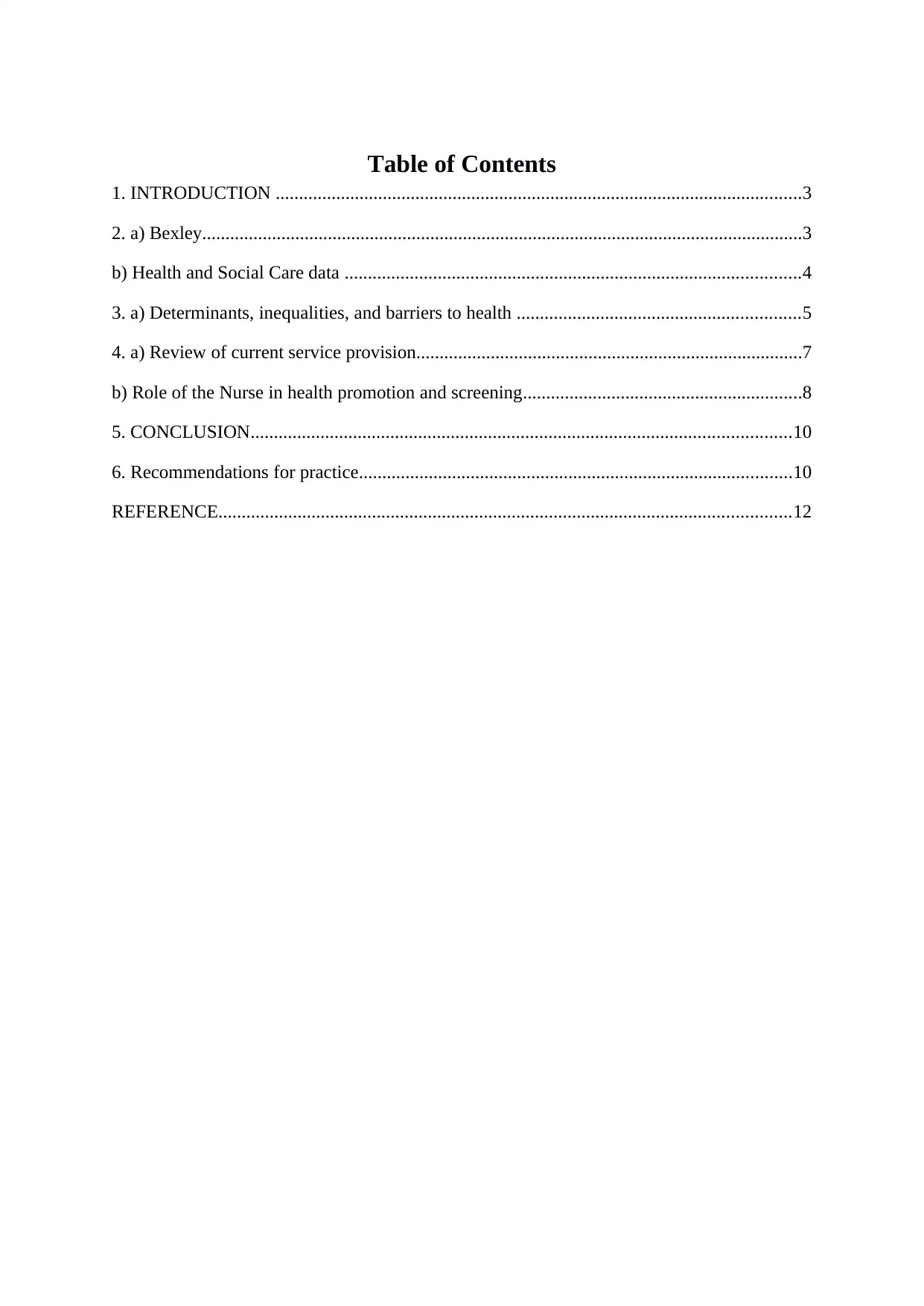
Table of Contents
1. INTRODUCTION .................................................................................................................3
2. a) Bexley.................................................................................................................................3
b) Health and Social Care data ..................................................................................................4
3. a) Determinants, inequalities, and barriers to health .............................................................5
4. a) Review of current service provision...................................................................................7
b) Role of the Nurse in health promotion and screening............................................................8
5. CONCLUSION....................................................................................................................10
6. Recommendations for practice.............................................................................................10
REFERENCE...........................................................................................................................12
1. INTRODUCTION .................................................................................................................3
2. a) Bexley.................................................................................................................................3
b) Health and Social Care data ..................................................................................................4
3. a) Determinants, inequalities, and barriers to health .............................................................5
4. a) Review of current service provision...................................................................................7
b) Role of the Nurse in health promotion and screening............................................................8
5. CONCLUSION....................................................................................................................10
6. Recommendations for practice.............................................................................................10
REFERENCE...........................................................................................................................12
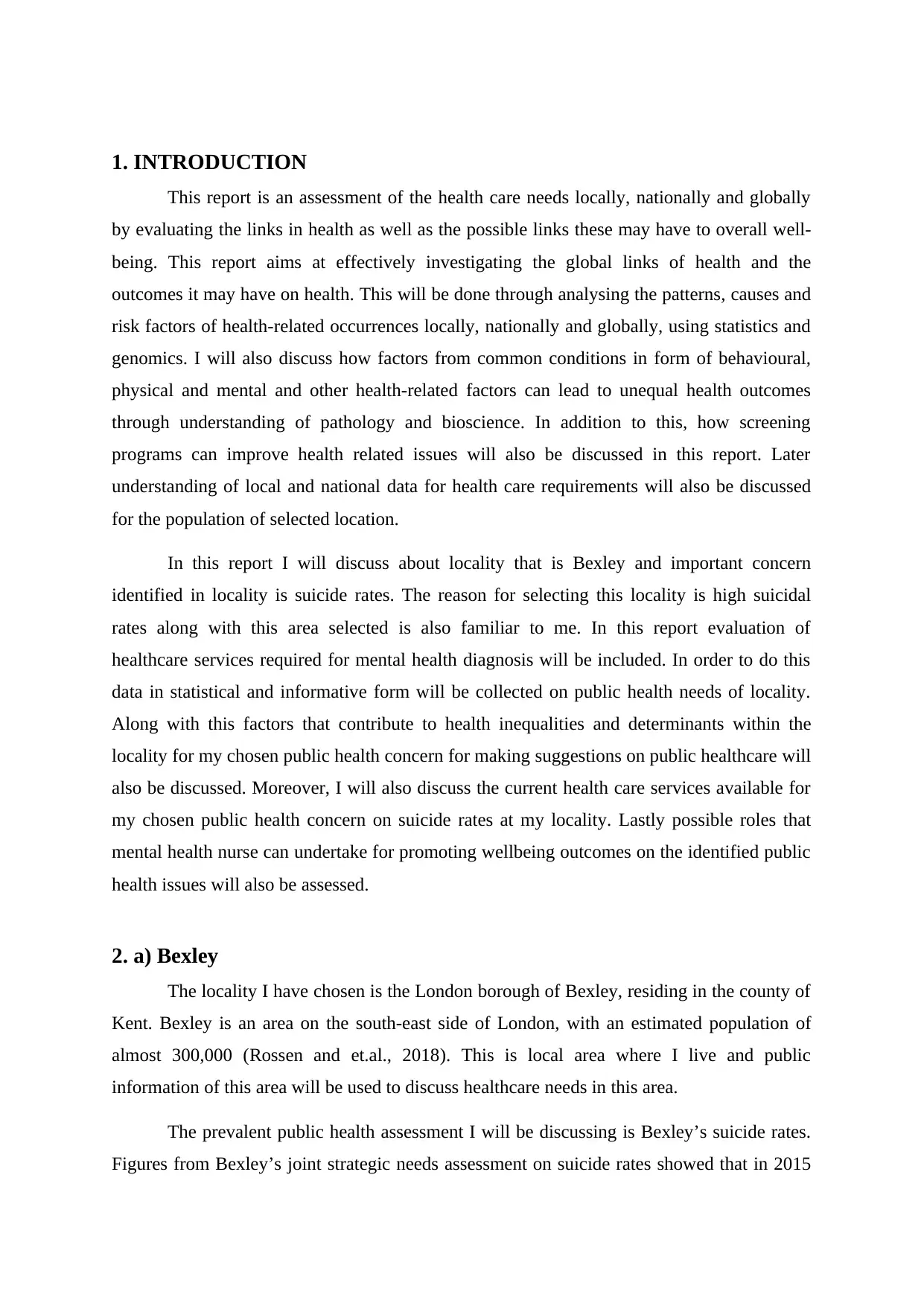
1. INTRODUCTION
This report is an assessment of the health care needs locally, nationally and globally
by evaluating the links in health as well as the possible links these may have to overall well-
being. This report aims at effectively investigating the global links of health and the
outcomes it may have on health. This will be done through analysing the patterns, causes and
risk factors of health-related occurrences locally, nationally and globally, using statistics and
genomics. I will also discuss how factors from common conditions in form of behavioural,
physical and mental and other health-related factors can lead to unequal health outcomes
through understanding of pathology and bioscience. In addition to this, how screening
programs can improve health related issues will also be discussed in this report. Later
understanding of local and national data for health care requirements will also be discussed
for the population of selected location.
In this report I will discuss about locality that is Bexley and important concern
identified in locality is suicide rates. The reason for selecting this locality is high suicidal
rates along with this area selected is also familiar to me. In this report evaluation of
healthcare services required for mental health diagnosis will be included. In order to do this
data in statistical and informative form will be collected on public health needs of locality.
Along with this factors that contribute to health inequalities and determinants within the
locality for my chosen public health concern for making suggestions on public healthcare will
also be discussed. Moreover, I will also discuss the current health care services available for
my chosen public health concern on suicide rates at my locality. Lastly possible roles that
mental health nurse can undertake for promoting wellbeing outcomes on the identified public
health issues will also be assessed.
2. a) Bexley
The locality I have chosen is the London borough of Bexley, residing in the county of
Kent. Bexley is an area on the south-east side of London, with an estimated population of
almost 300,000 (Rossen and et.al., 2018). This is local area where I live and public
information of this area will be used to discuss healthcare needs in this area.
The prevalent public health assessment I will be discussing is Bexley’s suicide rates.
Figures from Bexley’s joint strategic needs assessment on suicide rates showed that in 2015
This report is an assessment of the health care needs locally, nationally and globally
by evaluating the links in health as well as the possible links these may have to overall well-
being. This report aims at effectively investigating the global links of health and the
outcomes it may have on health. This will be done through analysing the patterns, causes and
risk factors of health-related occurrences locally, nationally and globally, using statistics and
genomics. I will also discuss how factors from common conditions in form of behavioural,
physical and mental and other health-related factors can lead to unequal health outcomes
through understanding of pathology and bioscience. In addition to this, how screening
programs can improve health related issues will also be discussed in this report. Later
understanding of local and national data for health care requirements will also be discussed
for the population of selected location.
In this report I will discuss about locality that is Bexley and important concern
identified in locality is suicide rates. The reason for selecting this locality is high suicidal
rates along with this area selected is also familiar to me. In this report evaluation of
healthcare services required for mental health diagnosis will be included. In order to do this
data in statistical and informative form will be collected on public health needs of locality.
Along with this factors that contribute to health inequalities and determinants within the
locality for my chosen public health concern for making suggestions on public healthcare will
also be discussed. Moreover, I will also discuss the current health care services available for
my chosen public health concern on suicide rates at my locality. Lastly possible roles that
mental health nurse can undertake for promoting wellbeing outcomes on the identified public
health issues will also be assessed.
2. a) Bexley
The locality I have chosen is the London borough of Bexley, residing in the county of
Kent. Bexley is an area on the south-east side of London, with an estimated population of
almost 300,000 (Rossen and et.al., 2018). This is local area where I live and public
information of this area will be used to discuss healthcare needs in this area.
The prevalent public health assessment I will be discussing is Bexley’s suicide rates.
Figures from Bexley’s joint strategic needs assessment on suicide rates showed that in 2015
You're viewing a preview
Unlock full access by subscribing today!
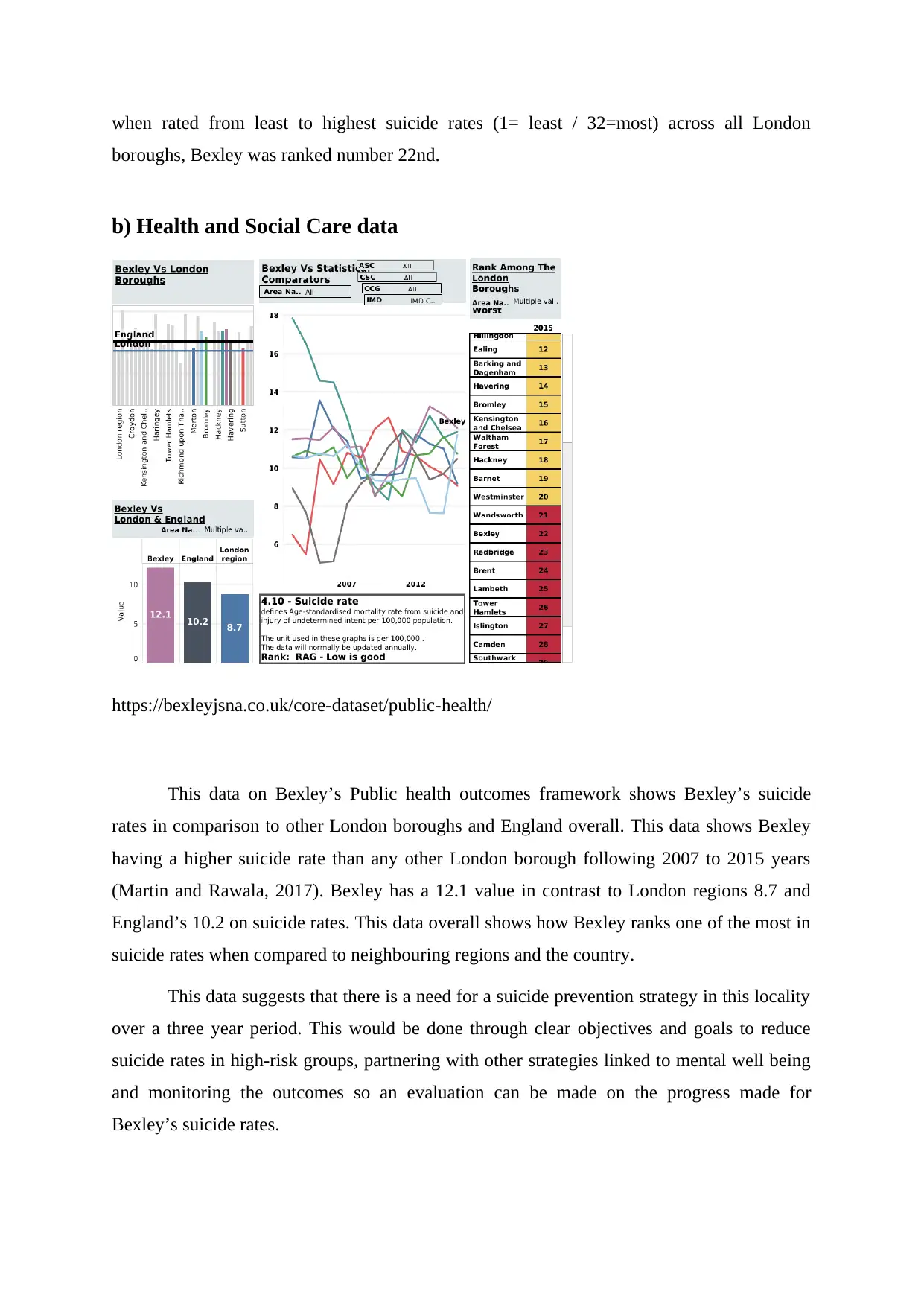
when rated from least to highest suicide rates (1= least / 32=most) across all London
boroughs, Bexley was ranked number 22nd.
b) Health and Social Care data
https://bexleyjsna.co.uk/core-dataset/public-health/
This data on Bexley’s Public health outcomes framework shows Bexley’s suicide
rates in comparison to other London boroughs and England overall. This data shows Bexley
having a higher suicide rate than any other London borough following 2007 to 2015 years
(Martin and Rawala, 2017). Bexley has a 12.1 value in contrast to London regions 8.7 and
England’s 10.2 on suicide rates. This data overall shows how Bexley ranks one of the most in
suicide rates when compared to neighbouring regions and the country.
This data suggests that there is a need for a suicide prevention strategy in this locality
over a three year period. This would be done through clear objectives and goals to reduce
suicide rates in high-risk groups, partnering with other strategies linked to mental well being
and monitoring the outcomes so an evaluation can be made on the progress made for
Bexley’s suicide rates.
boroughs, Bexley was ranked number 22nd.
b) Health and Social Care data
https://bexleyjsna.co.uk/core-dataset/public-health/
This data on Bexley’s Public health outcomes framework shows Bexley’s suicide
rates in comparison to other London boroughs and England overall. This data shows Bexley
having a higher suicide rate than any other London borough following 2007 to 2015 years
(Martin and Rawala, 2017). Bexley has a 12.1 value in contrast to London regions 8.7 and
England’s 10.2 on suicide rates. This data overall shows how Bexley ranks one of the most in
suicide rates when compared to neighbouring regions and the country.
This data suggests that there is a need for a suicide prevention strategy in this locality
over a three year period. This would be done through clear objectives and goals to reduce
suicide rates in high-risk groups, partnering with other strategies linked to mental well being
and monitoring the outcomes so an evaluation can be made on the progress made for
Bexley’s suicide rates.
Paraphrase This Document
Need a fresh take? Get an instant paraphrase of this document with our AI Paraphraser
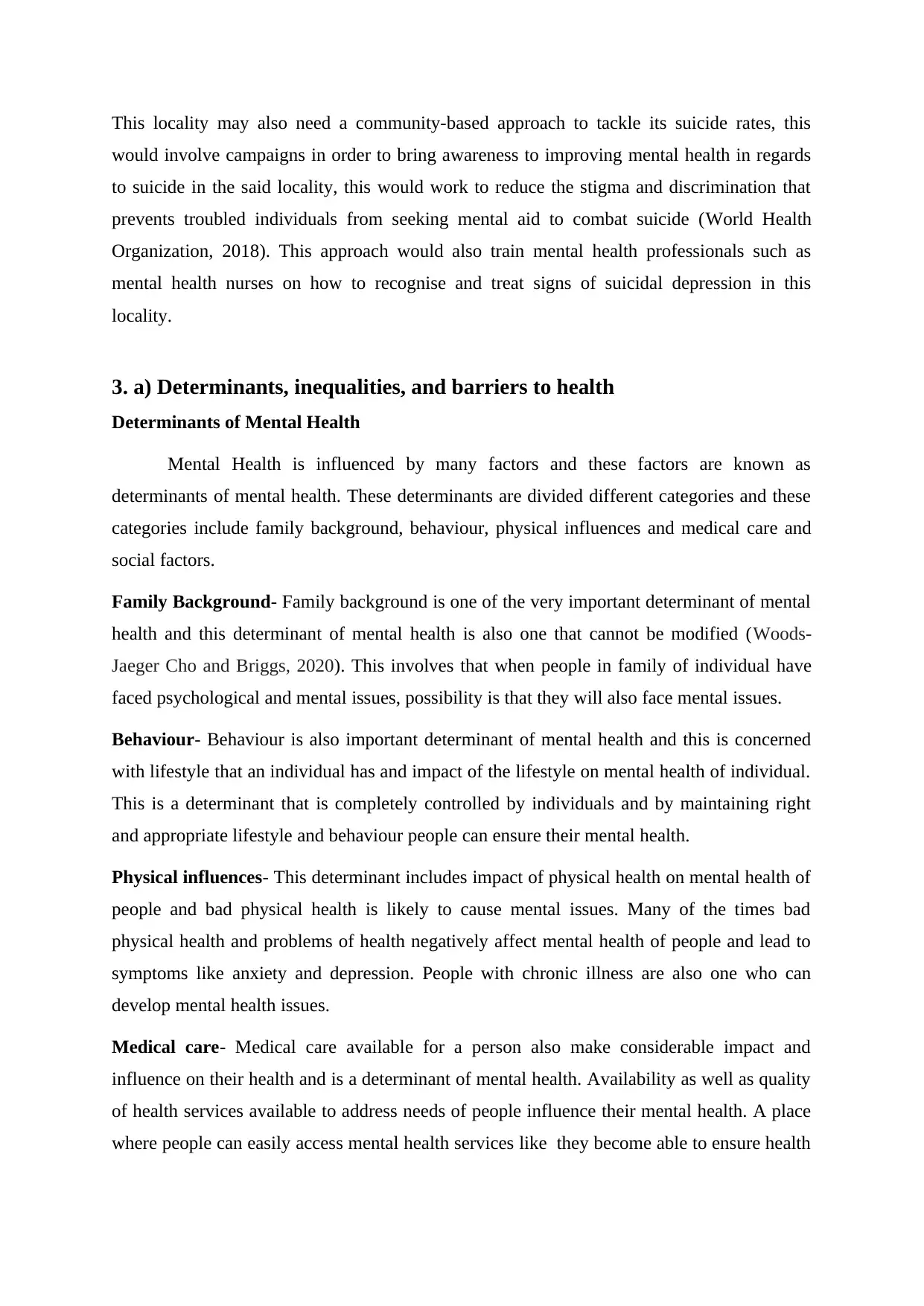
This locality may also need a community-based approach to tackle its suicide rates, this
would involve campaigns in order to bring awareness to improving mental health in regards
to suicide in the said locality, this would work to reduce the stigma and discrimination that
prevents troubled individuals from seeking mental aid to combat suicide (World Health
Organization, 2018). This approach would also train mental health professionals such as
mental health nurses on how to recognise and treat signs of suicidal depression in this
locality.
3. a) Determinants, inequalities, and barriers to health
Determinants of Mental Health
Mental Health is influenced by many factors and these factors are known as
determinants of mental health. These determinants are divided different categories and these
categories include family background, behaviour, physical influences and medical care and
social factors.
Family Background- Family background is one of the very important determinant of mental
health and this determinant of mental health is also one that cannot be modified (Woods-
Jaeger Cho and Briggs, 2020). This involves that when people in family of individual have
faced psychological and mental issues, possibility is that they will also face mental issues.
Behaviour- Behaviour is also important determinant of mental health and this is concerned
with lifestyle that an individual has and impact of the lifestyle on mental health of individual.
This is a determinant that is completely controlled by individuals and by maintaining right
and appropriate lifestyle and behaviour people can ensure their mental health.
Physical influences- This determinant includes impact of physical health on mental health of
people and bad physical health is likely to cause mental issues. Many of the times bad
physical health and problems of health negatively affect mental health of people and lead to
symptoms like anxiety and depression. People with chronic illness are also one who can
develop mental health issues.
Medical care- Medical care available for a person also make considerable impact and
influence on their health and is a determinant of mental health. Availability as well as quality
of health services available to address needs of people influence their mental health. A place
where people can easily access mental health services like they become able to ensure health
would involve campaigns in order to bring awareness to improving mental health in regards
to suicide in the said locality, this would work to reduce the stigma and discrimination that
prevents troubled individuals from seeking mental aid to combat suicide (World Health
Organization, 2018). This approach would also train mental health professionals such as
mental health nurses on how to recognise and treat signs of suicidal depression in this
locality.
3. a) Determinants, inequalities, and barriers to health
Determinants of Mental Health
Mental Health is influenced by many factors and these factors are known as
determinants of mental health. These determinants are divided different categories and these
categories include family background, behaviour, physical influences and medical care and
social factors.
Family Background- Family background is one of the very important determinant of mental
health and this determinant of mental health is also one that cannot be modified (Woods-
Jaeger Cho and Briggs, 2020). This involves that when people in family of individual have
faced psychological and mental issues, possibility is that they will also face mental issues.
Behaviour- Behaviour is also important determinant of mental health and this is concerned
with lifestyle that an individual has and impact of the lifestyle on mental health of individual.
This is a determinant that is completely controlled by individuals and by maintaining right
and appropriate lifestyle and behaviour people can ensure their mental health.
Physical influences- This determinant includes impact of physical health on mental health of
people and bad physical health is likely to cause mental issues. Many of the times bad
physical health and problems of health negatively affect mental health of people and lead to
symptoms like anxiety and depression. People with chronic illness are also one who can
develop mental health issues.
Medical care- Medical care available for a person also make considerable impact and
influence on their health and is a determinant of mental health. Availability as well as quality
of health services available to address needs of people influence their mental health. A place
where people can easily access mental health services like they become able to ensure health
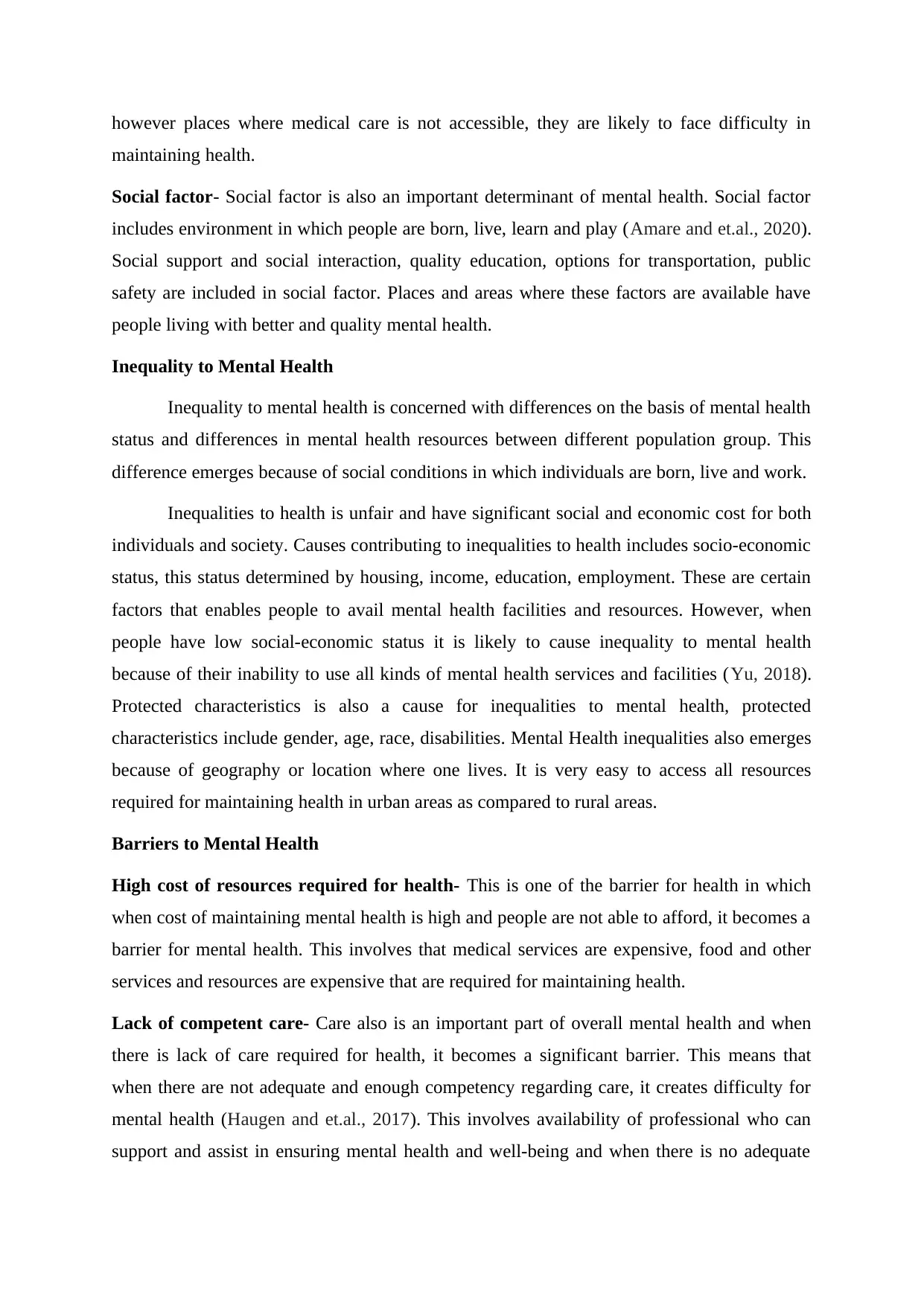
however places where medical care is not accessible, they are likely to face difficulty in
maintaining health.
Social factor- Social factor is also an important determinant of mental health. Social factor
includes environment in which people are born, live, learn and play (Amare and et.al., 2020).
Social support and social interaction, quality education, options for transportation, public
safety are included in social factor. Places and areas where these factors are available have
people living with better and quality mental health.
Inequality to Mental Health
Inequality to mental health is concerned with differences on the basis of mental health
status and differences in mental health resources between different population group. This
difference emerges because of social conditions in which individuals are born, live and work.
Inequalities to health is unfair and have significant social and economic cost for both
individuals and society. Causes contributing to inequalities to health includes socio-economic
status, this status determined by housing, income, education, employment. These are certain
factors that enables people to avail mental health facilities and resources. However, when
people have low social-economic status it is likely to cause inequality to mental health
because of their inability to use all kinds of mental health services and facilities (Yu, 2018).
Protected characteristics is also a cause for inequalities to mental health, protected
characteristics include gender, age, race, disabilities. Mental Health inequalities also emerges
because of geography or location where one lives. It is very easy to access all resources
required for maintaining health in urban areas as compared to rural areas.
Barriers to Mental Health
High cost of resources required for health- This is one of the barrier for health in which
when cost of maintaining mental health is high and people are not able to afford, it becomes a
barrier for mental health. This involves that medical services are expensive, food and other
services and resources are expensive that are required for maintaining health.
Lack of competent care- Care also is an important part of overall mental health and when
there is lack of care required for health, it becomes a significant barrier. This means that
when there are not adequate and enough competency regarding care, it creates difficulty for
mental health (Haugen and et.al., 2017). This involves availability of professional who can
support and assist in ensuring mental health and well-being and when there is no adequate
maintaining health.
Social factor- Social factor is also an important determinant of mental health. Social factor
includes environment in which people are born, live, learn and play (Amare and et.al., 2020).
Social support and social interaction, quality education, options for transportation, public
safety are included in social factor. Places and areas where these factors are available have
people living with better and quality mental health.
Inequality to Mental Health
Inequality to mental health is concerned with differences on the basis of mental health
status and differences in mental health resources between different population group. This
difference emerges because of social conditions in which individuals are born, live and work.
Inequalities to health is unfair and have significant social and economic cost for both
individuals and society. Causes contributing to inequalities to health includes socio-economic
status, this status determined by housing, income, education, employment. These are certain
factors that enables people to avail mental health facilities and resources. However, when
people have low social-economic status it is likely to cause inequality to mental health
because of their inability to use all kinds of mental health services and facilities (Yu, 2018).
Protected characteristics is also a cause for inequalities to mental health, protected
characteristics include gender, age, race, disabilities. Mental Health inequalities also emerges
because of geography or location where one lives. It is very easy to access all resources
required for maintaining health in urban areas as compared to rural areas.
Barriers to Mental Health
High cost of resources required for health- This is one of the barrier for health in which
when cost of maintaining mental health is high and people are not able to afford, it becomes a
barrier for mental health. This involves that medical services are expensive, food and other
services and resources are expensive that are required for maintaining health.
Lack of competent care- Care also is an important part of overall mental health and when
there is lack of care required for health, it becomes a significant barrier. This means that
when there are not adequate and enough competency regarding care, it creates difficulty for
mental health (Haugen and et.al., 2017). This involves availability of professional who can
support and assist in ensuring mental health and well-being and when there is no adequate
You're viewing a preview
Unlock full access by subscribing today!
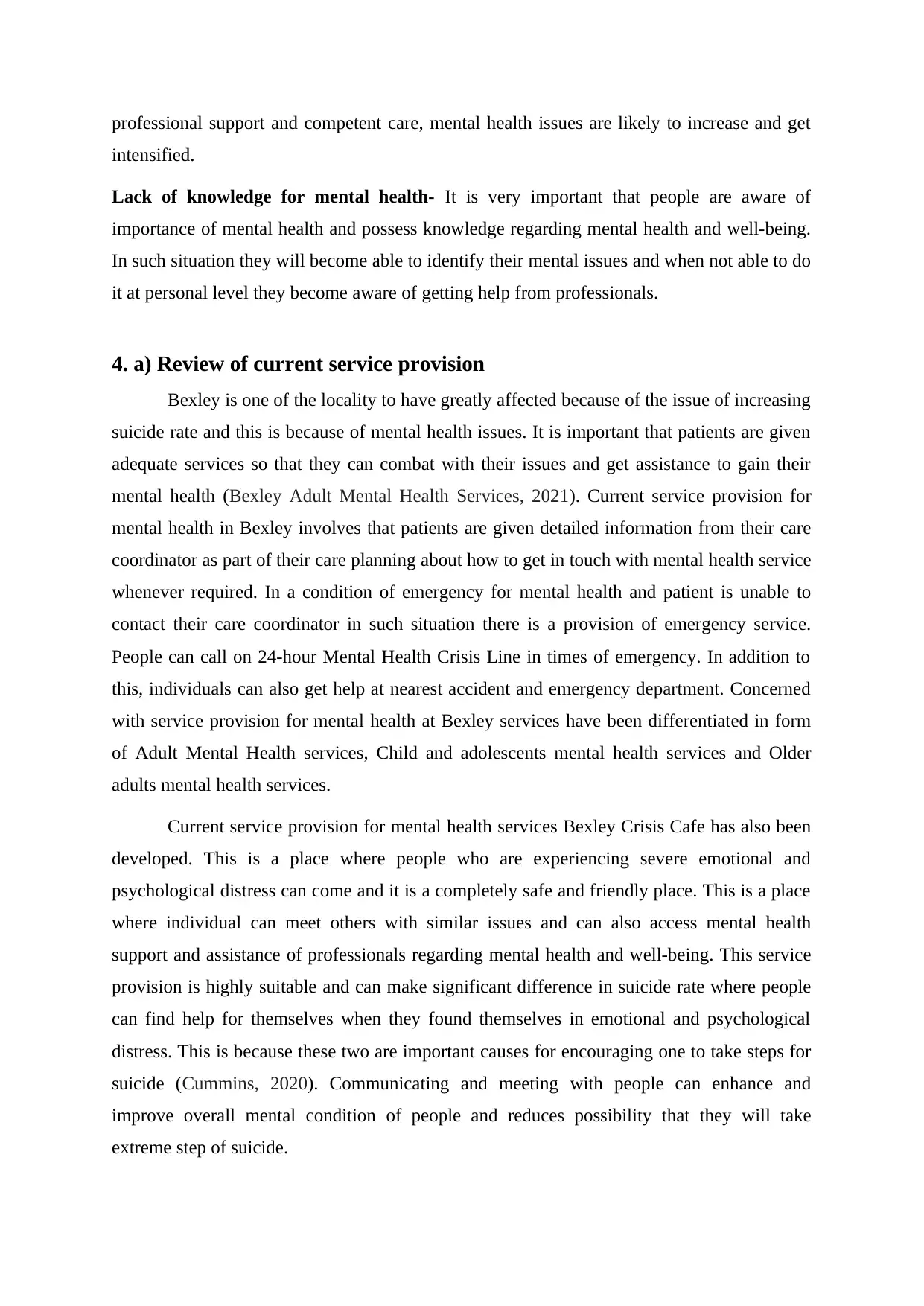
professional support and competent care, mental health issues are likely to increase and get
intensified.
Lack of knowledge for mental health- It is very important that people are aware of
importance of mental health and possess knowledge regarding mental health and well-being.
In such situation they will become able to identify their mental issues and when not able to do
it at personal level they become aware of getting help from professionals.
4. a) Review of current service provision
Bexley is one of the locality to have greatly affected because of the issue of increasing
suicide rate and this is because of mental health issues. It is important that patients are given
adequate services so that they can combat with their issues and get assistance to gain their
mental health (Bexley Adult Mental Health Services, 2021). Current service provision for
mental health in Bexley involves that patients are given detailed information from their care
coordinator as part of their care planning about how to get in touch with mental health service
whenever required. In a condition of emergency for mental health and patient is unable to
contact their care coordinator in such situation there is a provision of emergency service.
People can call on 24-hour Mental Health Crisis Line in times of emergency. In addition to
this, individuals can also get help at nearest accident and emergency department. Concerned
with service provision for mental health at Bexley services have been differentiated in form
of Adult Mental Health services, Child and adolescents mental health services and Older
adults mental health services.
Current service provision for mental health services Bexley Crisis Cafe has also been
developed. This is a place where people who are experiencing severe emotional and
psychological distress can come and it is a completely safe and friendly place. This is a place
where individual can meet others with similar issues and can also access mental health
support and assistance of professionals regarding mental health and well-being. This service
provision is highly suitable and can make significant difference in suicide rate where people
can find help for themselves when they found themselves in emotional and psychological
distress. This is because these two are important causes for encouraging one to take steps for
suicide (Cummins, 2020). Communicating and meeting with people can enhance and
improve overall mental condition of people and reduces possibility that they will take
extreme step of suicide.
intensified.
Lack of knowledge for mental health- It is very important that people are aware of
importance of mental health and possess knowledge regarding mental health and well-being.
In such situation they will become able to identify their mental issues and when not able to do
it at personal level they become aware of getting help from professionals.
4. a) Review of current service provision
Bexley is one of the locality to have greatly affected because of the issue of increasing
suicide rate and this is because of mental health issues. It is important that patients are given
adequate services so that they can combat with their issues and get assistance to gain their
mental health (Bexley Adult Mental Health Services, 2021). Current service provision for
mental health in Bexley involves that patients are given detailed information from their care
coordinator as part of their care planning about how to get in touch with mental health service
whenever required. In a condition of emergency for mental health and patient is unable to
contact their care coordinator in such situation there is a provision of emergency service.
People can call on 24-hour Mental Health Crisis Line in times of emergency. In addition to
this, individuals can also get help at nearest accident and emergency department. Concerned
with service provision for mental health at Bexley services have been differentiated in form
of Adult Mental Health services, Child and adolescents mental health services and Older
adults mental health services.
Current service provision for mental health services Bexley Crisis Cafe has also been
developed. This is a place where people who are experiencing severe emotional and
psychological distress can come and it is a completely safe and friendly place. This is a place
where individual can meet others with similar issues and can also access mental health
support and assistance of professionals regarding mental health and well-being. This service
provision is highly suitable and can make significant difference in suicide rate where people
can find help for themselves when they found themselves in emotional and psychological
distress. This is because these two are important causes for encouraging one to take steps for
suicide (Cummins, 2020). Communicating and meeting with people can enhance and
improve overall mental condition of people and reduces possibility that they will take
extreme step of suicide.
Paraphrase This Document
Need a fresh take? Get an instant paraphrase of this document with our AI Paraphraser
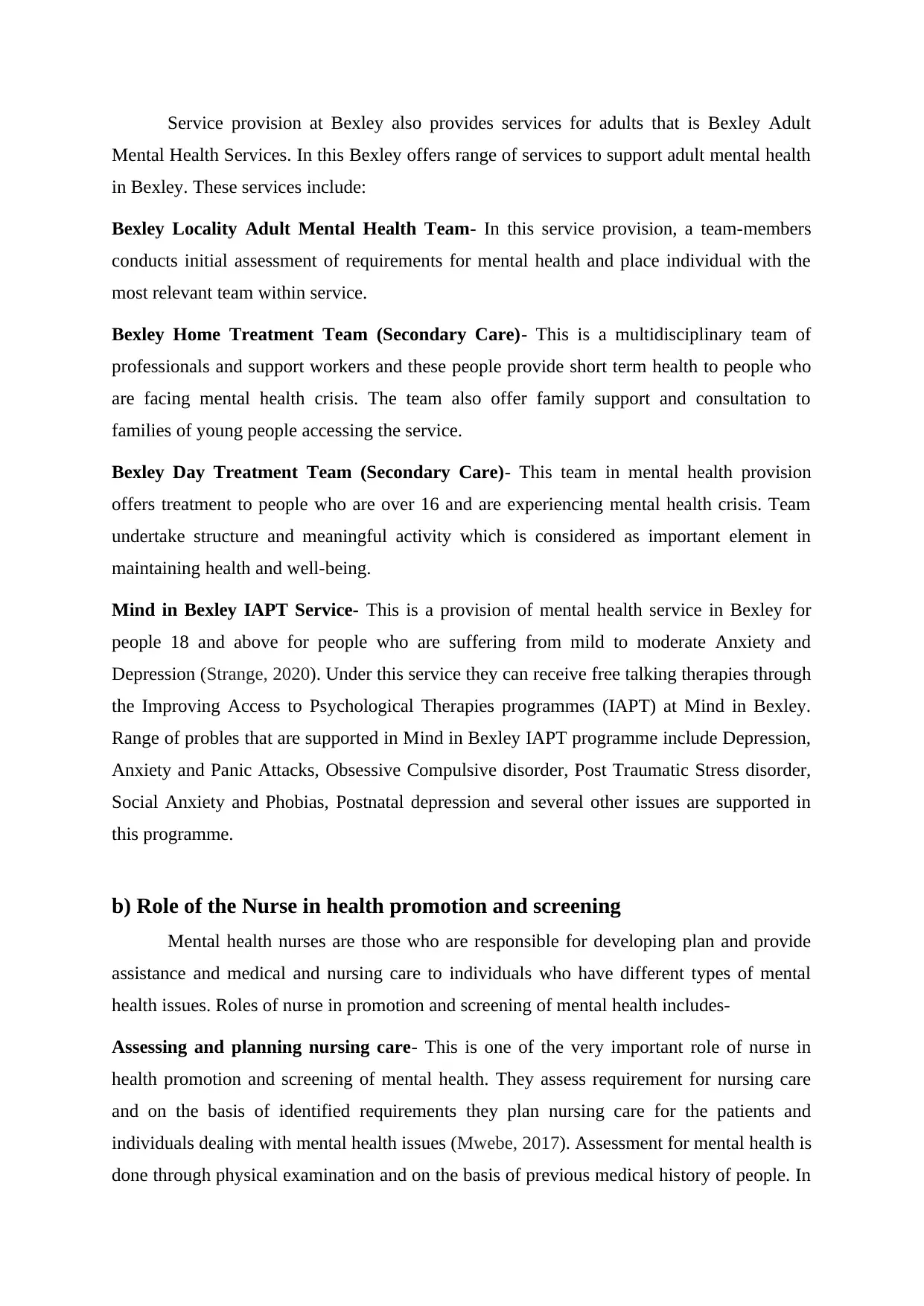
Service provision at Bexley also provides services for adults that is Bexley Adult
Mental Health Services. In this Bexley offers range of services to support adult mental health
in Bexley. These services include:
Bexley Locality Adult Mental Health Team- In this service provision, a team-members
conducts initial assessment of requirements for mental health and place individual with the
most relevant team within service.
Bexley Home Treatment Team (Secondary Care)- This is a multidisciplinary team of
professionals and support workers and these people provide short term health to people who
are facing mental health crisis. The team also offer family support and consultation to
families of young people accessing the service.
Bexley Day Treatment Team (Secondary Care)- This team in mental health provision
offers treatment to people who are over 16 and are experiencing mental health crisis. Team
undertake structure and meaningful activity which is considered as important element in
maintaining health and well-being.
Mind in Bexley IAPT Service- This is a provision of mental health service in Bexley for
people 18 and above for people who are suffering from mild to moderate Anxiety and
Depression (Strange, 2020). Under this service they can receive free talking therapies through
the Improving Access to Psychological Therapies programmes (IAPT) at Mind in Bexley.
Range of probles that are supported in Mind in Bexley IAPT programme include Depression,
Anxiety and Panic Attacks, Obsessive Compulsive disorder, Post Traumatic Stress disorder,
Social Anxiety and Phobias, Postnatal depression and several other issues are supported in
this programme.
b) Role of the Nurse in health promotion and screening
Mental health nurses are those who are responsible for developing plan and provide
assistance and medical and nursing care to individuals who have different types of mental
health issues. Roles of nurse in promotion and screening of mental health includes-
Assessing and planning nursing care- This is one of the very important role of nurse in
health promotion and screening of mental health. They assess requirement for nursing care
and on the basis of identified requirements they plan nursing care for the patients and
individuals dealing with mental health issues (Mwebe, 2017). Assessment for mental health is
done through physical examination and on the basis of previous medical history of people. In
Mental Health Services. In this Bexley offers range of services to support adult mental health
in Bexley. These services include:
Bexley Locality Adult Mental Health Team- In this service provision, a team-members
conducts initial assessment of requirements for mental health and place individual with the
most relevant team within service.
Bexley Home Treatment Team (Secondary Care)- This is a multidisciplinary team of
professionals and support workers and these people provide short term health to people who
are facing mental health crisis. The team also offer family support and consultation to
families of young people accessing the service.
Bexley Day Treatment Team (Secondary Care)- This team in mental health provision
offers treatment to people who are over 16 and are experiencing mental health crisis. Team
undertake structure and meaningful activity which is considered as important element in
maintaining health and well-being.
Mind in Bexley IAPT Service- This is a provision of mental health service in Bexley for
people 18 and above for people who are suffering from mild to moderate Anxiety and
Depression (Strange, 2020). Under this service they can receive free talking therapies through
the Improving Access to Psychological Therapies programmes (IAPT) at Mind in Bexley.
Range of probles that are supported in Mind in Bexley IAPT programme include Depression,
Anxiety and Panic Attacks, Obsessive Compulsive disorder, Post Traumatic Stress disorder,
Social Anxiety and Phobias, Postnatal depression and several other issues are supported in
this programme.
b) Role of the Nurse in health promotion and screening
Mental health nurses are those who are responsible for developing plan and provide
assistance and medical and nursing care to individuals who have different types of mental
health issues. Roles of nurse in promotion and screening of mental health includes-
Assessing and planning nursing care- This is one of the very important role of nurse in
health promotion and screening of mental health. They assess requirement for nursing care
and on the basis of identified requirements they plan nursing care for the patients and
individuals dealing with mental health issues (Mwebe, 2017). Assessment for mental health is
done through physical examination and on the basis of previous medical history of people. In
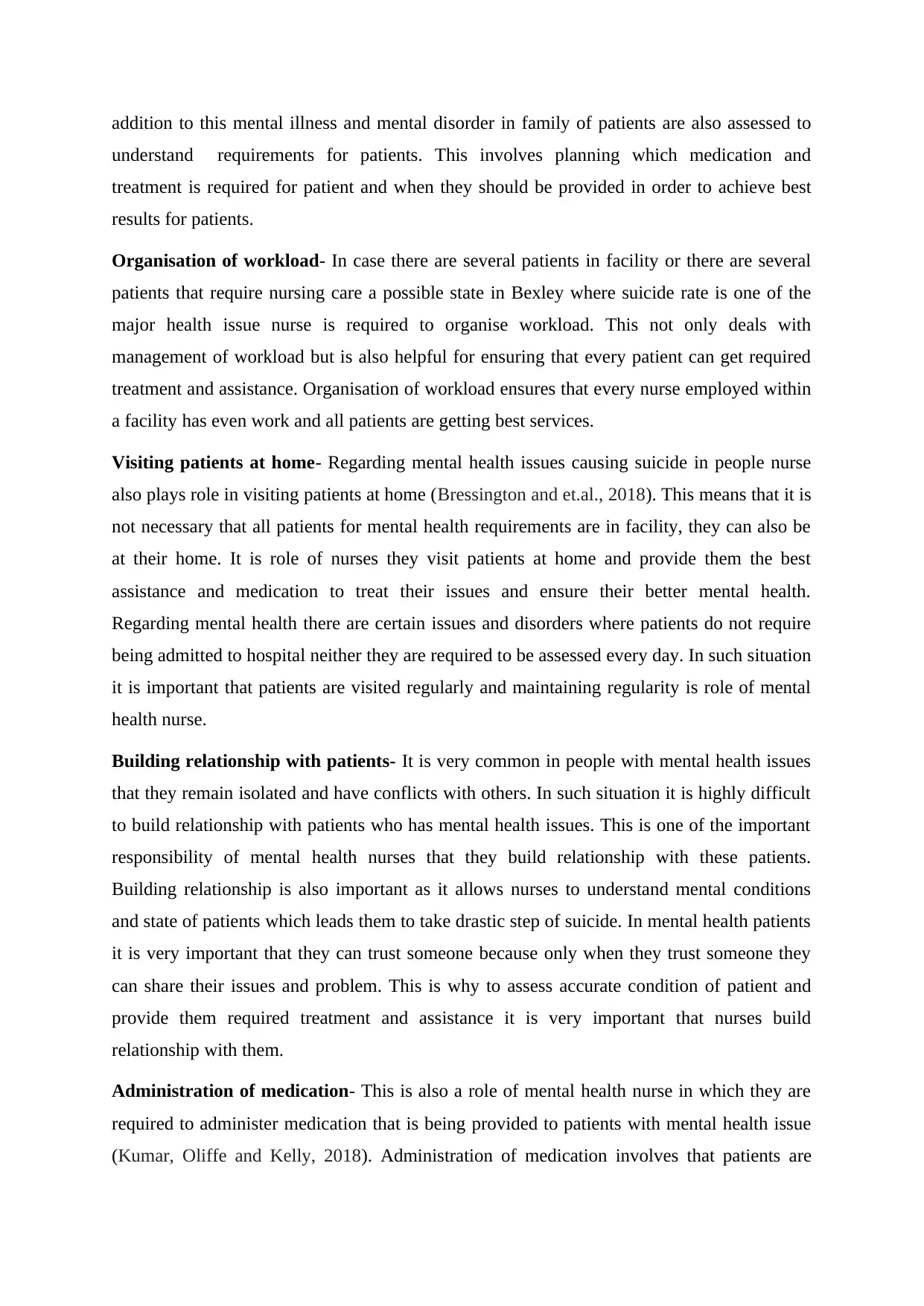
addition to this mental illness and mental disorder in family of patients are also assessed to
understand requirements for patients. This involves planning which medication and
treatment is required for patient and when they should be provided in order to achieve best
results for patients.
Organisation of workload- In case there are several patients in facility or there are several
patients that require nursing care a possible state in Bexley where suicide rate is one of the
major health issue nurse is required to organise workload. This not only deals with
management of workload but is also helpful for ensuring that every patient can get required
treatment and assistance. Organisation of workload ensures that every nurse employed within
a facility has even work and all patients are getting best services.
Visiting patients at home- Regarding mental health issues causing suicide in people nurse
also plays role in visiting patients at home (Bressington and et.al., 2018). This means that it is
not necessary that all patients for mental health requirements are in facility, they can also be
at their home. It is role of nurses they visit patients at home and provide them the best
assistance and medication to treat their issues and ensure their better mental health.
Regarding mental health there are certain issues and disorders where patients do not require
being admitted to hospital neither they are required to be assessed every day. In such situation
it is important that patients are visited regularly and maintaining regularity is role of mental
health nurse.
Building relationship with patients- It is very common in people with mental health issues
that they remain isolated and have conflicts with others. In such situation it is highly difficult
to build relationship with patients who has mental health issues. This is one of the important
responsibility of mental health nurses that they build relationship with these patients.
Building relationship is also important as it allows nurses to understand mental conditions
and state of patients which leads them to take drastic step of suicide. In mental health patients
it is very important that they can trust someone because only when they trust someone they
can share their issues and problem. This is why to assess accurate condition of patient and
provide them required treatment and assistance it is very important that nurses build
relationship with them.
Administration of medication- This is also a role of mental health nurse in which they are
required to administer medication that is being provided to patients with mental health issue
(Kumar, Oliffe and Kelly, 2018). Administration of medication involves that patients are
understand requirements for patients. This involves planning which medication and
treatment is required for patient and when they should be provided in order to achieve best
results for patients.
Organisation of workload- In case there are several patients in facility or there are several
patients that require nursing care a possible state in Bexley where suicide rate is one of the
major health issue nurse is required to organise workload. This not only deals with
management of workload but is also helpful for ensuring that every patient can get required
treatment and assistance. Organisation of workload ensures that every nurse employed within
a facility has even work and all patients are getting best services.
Visiting patients at home- Regarding mental health issues causing suicide in people nurse
also plays role in visiting patients at home (Bressington and et.al., 2018). This means that it is
not necessary that all patients for mental health requirements are in facility, they can also be
at their home. It is role of nurses they visit patients at home and provide them the best
assistance and medication to treat their issues and ensure their better mental health.
Regarding mental health there are certain issues and disorders where patients do not require
being admitted to hospital neither they are required to be assessed every day. In such situation
it is important that patients are visited regularly and maintaining regularity is role of mental
health nurse.
Building relationship with patients- It is very common in people with mental health issues
that they remain isolated and have conflicts with others. In such situation it is highly difficult
to build relationship with patients who has mental health issues. This is one of the important
responsibility of mental health nurses that they build relationship with these patients.
Building relationship is also important as it allows nurses to understand mental conditions
and state of patients which leads them to take drastic step of suicide. In mental health patients
it is very important that they can trust someone because only when they trust someone they
can share their issues and problem. This is why to assess accurate condition of patient and
provide them required treatment and assistance it is very important that nurses build
relationship with them.
Administration of medication- This is also a role of mental health nurse in which they are
required to administer medication that is being provided to patients with mental health issue
(Kumar, Oliffe and Kelly, 2018). Administration of medication involves that patients are
You're viewing a preview
Unlock full access by subscribing today!
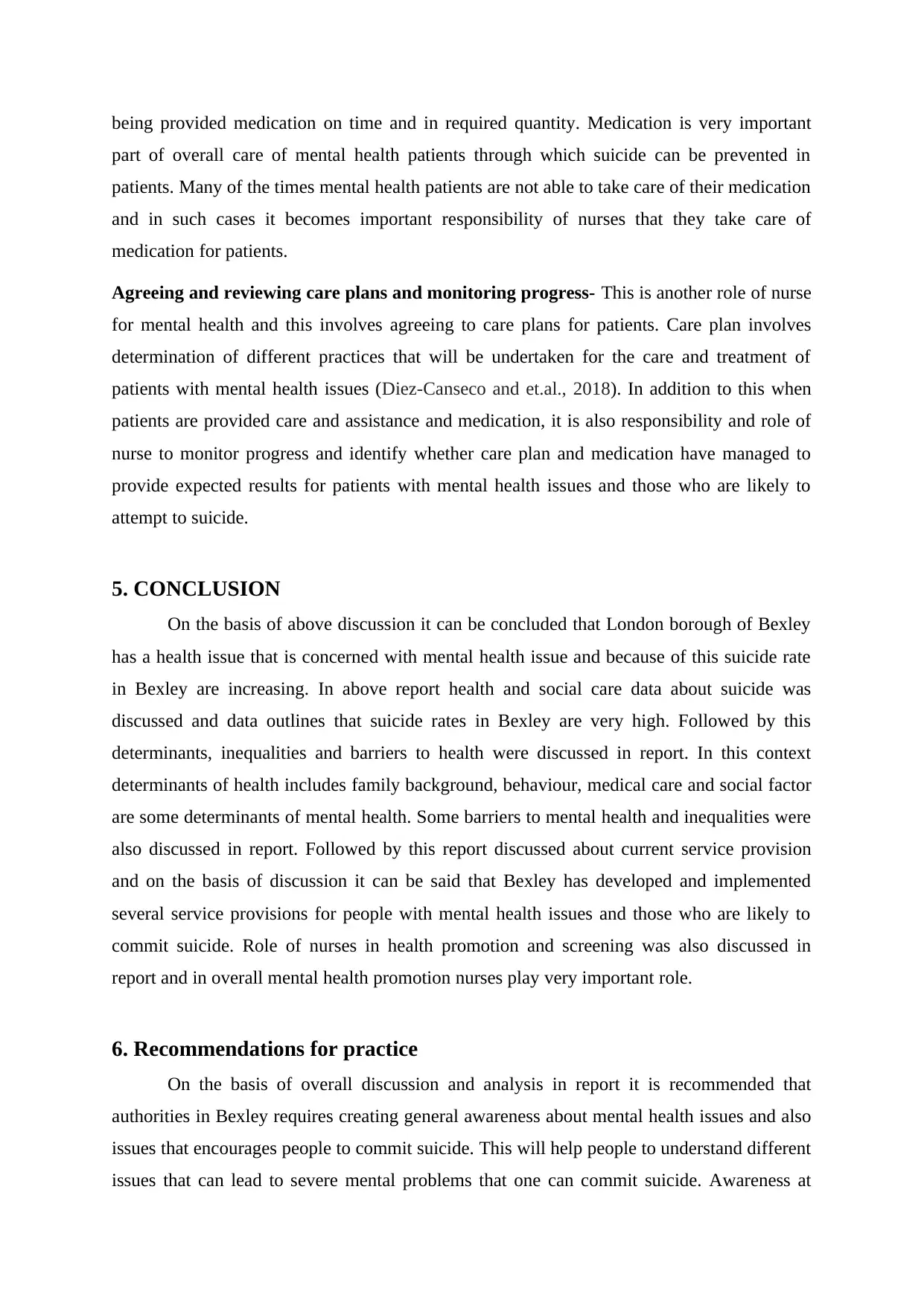
being provided medication on time and in required quantity. Medication is very important
part of overall care of mental health patients through which suicide can be prevented in
patients. Many of the times mental health patients are not able to take care of their medication
and in such cases it becomes important responsibility of nurses that they take care of
medication for patients.
Agreeing and reviewing care plans and monitoring progress- This is another role of nurse
for mental health and this involves agreeing to care plans for patients. Care plan involves
determination of different practices that will be undertaken for the care and treatment of
patients with mental health issues (Diez-Canseco and et.al., 2018). In addition to this when
patients are provided care and assistance and medication, it is also responsibility and role of
nurse to monitor progress and identify whether care plan and medication have managed to
provide expected results for patients with mental health issues and those who are likely to
attempt to suicide.
5. CONCLUSION
On the basis of above discussion it can be concluded that London borough of Bexley
has a health issue that is concerned with mental health issue and because of this suicide rate
in Bexley are increasing. In above report health and social care data about suicide was
discussed and data outlines that suicide rates in Bexley are very high. Followed by this
determinants, inequalities and barriers to health were discussed in report. In this context
determinants of health includes family background, behaviour, medical care and social factor
are some determinants of mental health. Some barriers to mental health and inequalities were
also discussed in report. Followed by this report discussed about current service provision
and on the basis of discussion it can be said that Bexley has developed and implemented
several service provisions for people with mental health issues and those who are likely to
commit suicide. Role of nurses in health promotion and screening was also discussed in
report and in overall mental health promotion nurses play very important role.
6. Recommendations for practice
On the basis of overall discussion and analysis in report it is recommended that
authorities in Bexley requires creating general awareness about mental health issues and also
issues that encourages people to commit suicide. This will help people to understand different
issues that can lead to severe mental problems that one can commit suicide. Awareness at
part of overall care of mental health patients through which suicide can be prevented in
patients. Many of the times mental health patients are not able to take care of their medication
and in such cases it becomes important responsibility of nurses that they take care of
medication for patients.
Agreeing and reviewing care plans and monitoring progress- This is another role of nurse
for mental health and this involves agreeing to care plans for patients. Care plan involves
determination of different practices that will be undertaken for the care and treatment of
patients with mental health issues (Diez-Canseco and et.al., 2018). In addition to this when
patients are provided care and assistance and medication, it is also responsibility and role of
nurse to monitor progress and identify whether care plan and medication have managed to
provide expected results for patients with mental health issues and those who are likely to
attempt to suicide.
5. CONCLUSION
On the basis of above discussion it can be concluded that London borough of Bexley
has a health issue that is concerned with mental health issue and because of this suicide rate
in Bexley are increasing. In above report health and social care data about suicide was
discussed and data outlines that suicide rates in Bexley are very high. Followed by this
determinants, inequalities and barriers to health were discussed in report. In this context
determinants of health includes family background, behaviour, medical care and social factor
are some determinants of mental health. Some barriers to mental health and inequalities were
also discussed in report. Followed by this report discussed about current service provision
and on the basis of discussion it can be said that Bexley has developed and implemented
several service provisions for people with mental health issues and those who are likely to
commit suicide. Role of nurses in health promotion and screening was also discussed in
report and in overall mental health promotion nurses play very important role.
6. Recommendations for practice
On the basis of overall discussion and analysis in report it is recommended that
authorities in Bexley requires creating general awareness about mental health issues and also
issues that encourages people to commit suicide. This will help people to understand different
issues that can lead to severe mental problems that one can commit suicide. Awareness at
Paraphrase This Document
Need a fresh take? Get an instant paraphrase of this document with our AI Paraphraser
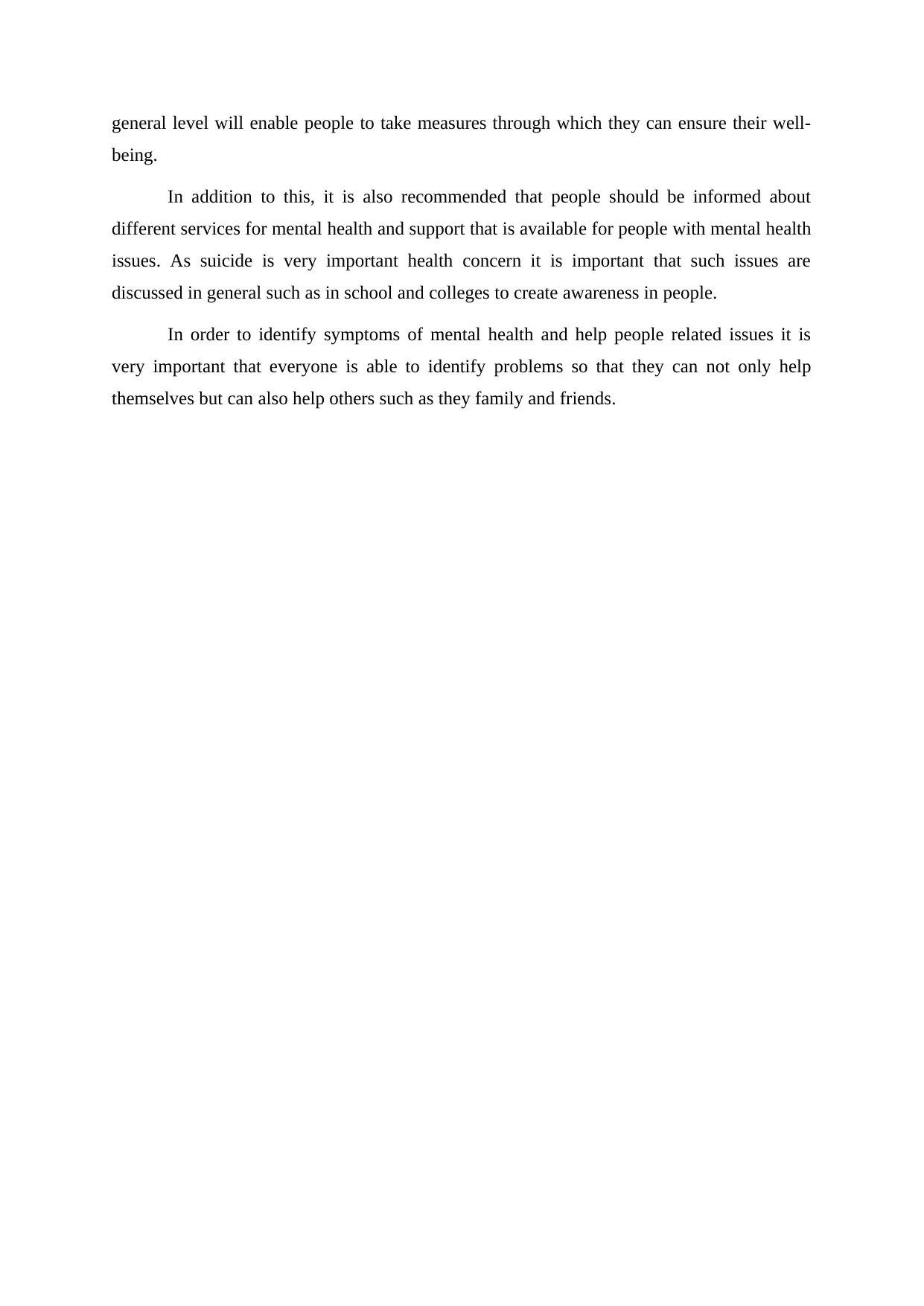
general level will enable people to take measures through which they can ensure their well-
being.
In addition to this, it is also recommended that people should be informed about
different services for mental health and support that is available for people with mental health
issues. As suicide is very important health concern it is important that such issues are
discussed in general such as in school and colleges to create awareness in people.
In order to identify symptoms of mental health and help people related issues it is
very important that everyone is able to identify problems so that they can not only help
themselves but can also help others such as they family and friends.
being.
In addition to this, it is also recommended that people should be informed about
different services for mental health and support that is available for people with mental health
issues. As suicide is very important health concern it is important that such issues are
discussed in general such as in school and colleges to create awareness in people.
In order to identify symptoms of mental health and help people related issues it is
very important that everyone is able to identify problems so that they can not only help
themselves but can also help others such as they family and friends.
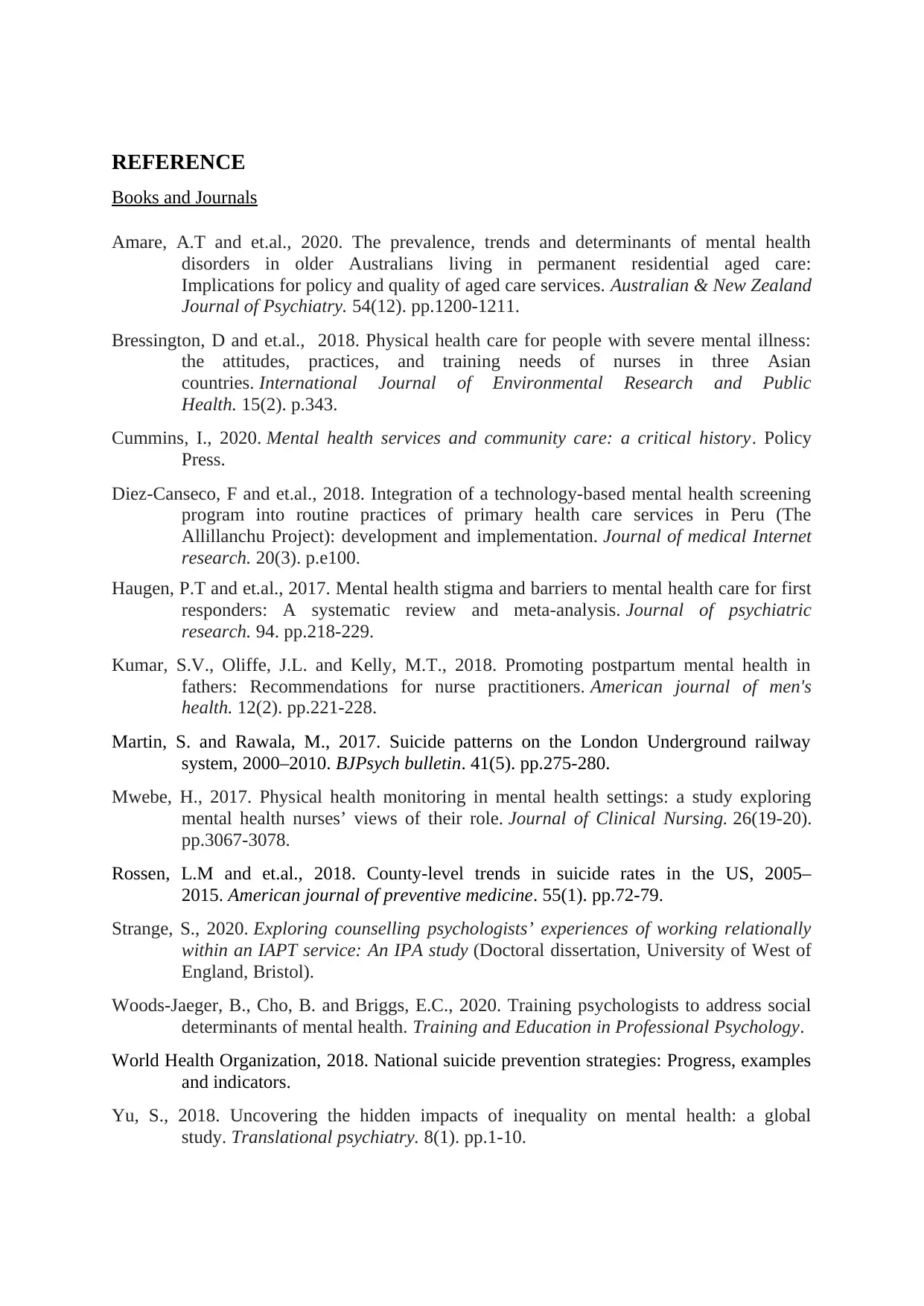
REFERENCE
Books and Journals
Amare, A.T and et.al., 2020. The prevalence, trends and determinants of mental health
disorders in older Australians living in permanent residential aged care:
Implications for policy and quality of aged care services. Australian & New Zealand
Journal of Psychiatry. 54(12). pp.1200-1211.
Bressington, D and et.al., 2018. Physical health care for people with severe mental illness:
the attitudes, practices, and training needs of nurses in three Asian
countries. International Journal of Environmental Research and Public
Health. 15(2). p.343.
Cummins, I., 2020. Mental health services and community care: a critical history. Policy
Press.
Diez-Canseco, F and et.al., 2018. Integration of a technology-based mental health screening
program into routine practices of primary health care services in Peru (The
Allillanchu Project): development and implementation. Journal of medical Internet
research. 20(3). p.e100.
Haugen, P.T and et.al., 2017. Mental health stigma and barriers to mental health care for first
responders: A systematic review and meta-analysis. Journal of psychiatric
research. 94. pp.218-229.
Kumar, S.V., Oliffe, J.L. and Kelly, M.T., 2018. Promoting postpartum mental health in
fathers: Recommendations for nurse practitioners. American journal of men's
health. 12(2). pp.221-228.
Martin, S. and Rawala, M., 2017. Suicide patterns on the London Underground railway
system, 2000–2010. BJPsych bulletin. 41(5). pp.275-280.
Mwebe, H., 2017. Physical health monitoring in mental health settings: a study exploring
mental health nurses’ views of their role. Journal of Clinical Nursing. 26(19-20).
pp.3067-3078.
Rossen, L.M and et.al., 2018. County-level trends in suicide rates in the US, 2005–
2015. American journal of preventive medicine. 55(1). pp.72-79.
Strange, S., 2020. Exploring counselling psychologists’ experiences of working relationally
within an IAPT service: An IPA study (Doctoral dissertation, University of West of
England, Bristol).
Woods-Jaeger, B., Cho, B. and Briggs, E.C., 2020. Training psychologists to address social
determinants of mental health. Training and Education in Professional Psychology.
World Health Organization, 2018. National suicide prevention strategies: Progress, examples
and indicators.
Yu, S., 2018. Uncovering the hidden impacts of inequality on mental health: a global
study. Translational psychiatry. 8(1). pp.1-10.
Books and Journals
Amare, A.T and et.al., 2020. The prevalence, trends and determinants of mental health
disorders in older Australians living in permanent residential aged care:
Implications for policy and quality of aged care services. Australian & New Zealand
Journal of Psychiatry. 54(12). pp.1200-1211.
Bressington, D and et.al., 2018. Physical health care for people with severe mental illness:
the attitudes, practices, and training needs of nurses in three Asian
countries. International Journal of Environmental Research and Public
Health. 15(2). p.343.
Cummins, I., 2020. Mental health services and community care: a critical history. Policy
Press.
Diez-Canseco, F and et.al., 2018. Integration of a technology-based mental health screening
program into routine practices of primary health care services in Peru (The
Allillanchu Project): development and implementation. Journal of medical Internet
research. 20(3). p.e100.
Haugen, P.T and et.al., 2017. Mental health stigma and barriers to mental health care for first
responders: A systematic review and meta-analysis. Journal of psychiatric
research. 94. pp.218-229.
Kumar, S.V., Oliffe, J.L. and Kelly, M.T., 2018. Promoting postpartum mental health in
fathers: Recommendations for nurse practitioners. American journal of men's
health. 12(2). pp.221-228.
Martin, S. and Rawala, M., 2017. Suicide patterns on the London Underground railway
system, 2000–2010. BJPsych bulletin. 41(5). pp.275-280.
Mwebe, H., 2017. Physical health monitoring in mental health settings: a study exploring
mental health nurses’ views of their role. Journal of Clinical Nursing. 26(19-20).
pp.3067-3078.
Rossen, L.M and et.al., 2018. County-level trends in suicide rates in the US, 2005–
2015. American journal of preventive medicine. 55(1). pp.72-79.
Strange, S., 2020. Exploring counselling psychologists’ experiences of working relationally
within an IAPT service: An IPA study (Doctoral dissertation, University of West of
England, Bristol).
Woods-Jaeger, B., Cho, B. and Briggs, E.C., 2020. Training psychologists to address social
determinants of mental health. Training and Education in Professional Psychology.
World Health Organization, 2018. National suicide prevention strategies: Progress, examples
and indicators.
Yu, S., 2018. Uncovering the hidden impacts of inequality on mental health: a global
study. Translational psychiatry. 8(1). pp.1-10.
You're viewing a preview
Unlock full access by subscribing today!

Online
Bexley Adult Mental Health Services. 2021. [Online]. Available Through:
<https://www.bexleylocaloffer.uk/Services/5397#>.
https://bexleyjsna.co.uk/core-dataset/public-health/
https://fingertips.phe.org.uk/profile/public-health-outcomes-framework/data#page/1/gid/
1000044/pat/6/par/E12000007/ati/302/are/E09000004/cid/4
https://fingertips.phe.org.uk/profile/public-health-outcomes-framework/data#page/3/gid/
1000044/pat/6/par/E12000007/ati/302/are/E09000004/iid/41001/age/285/sex/4/cid/4/page-
options/car-do-0
Bexley Adult Mental Health Services. 2021. [Online]. Available Through:
<https://www.bexleylocaloffer.uk/Services/5397#>.
https://bexleyjsna.co.uk/core-dataset/public-health/
https://fingertips.phe.org.uk/profile/public-health-outcomes-framework/data#page/1/gid/
1000044/pat/6/par/E12000007/ati/302/are/E09000004/cid/4
https://fingertips.phe.org.uk/profile/public-health-outcomes-framework/data#page/3/gid/
1000044/pat/6/par/E12000007/ati/302/are/E09000004/iid/41001/age/285/sex/4/cid/4/page-
options/car-do-0
1 out of 13
Related Documents
Your All-in-One AI-Powered Toolkit for Academic Success.
+13062052269
info@desklib.com
Available 24*7 on WhatsApp / Email
![[object Object]](/_next/static/media/star-bottom.7253800d.svg)
Unlock your academic potential
© 2024 | Zucol Services PVT LTD | All rights reserved.




